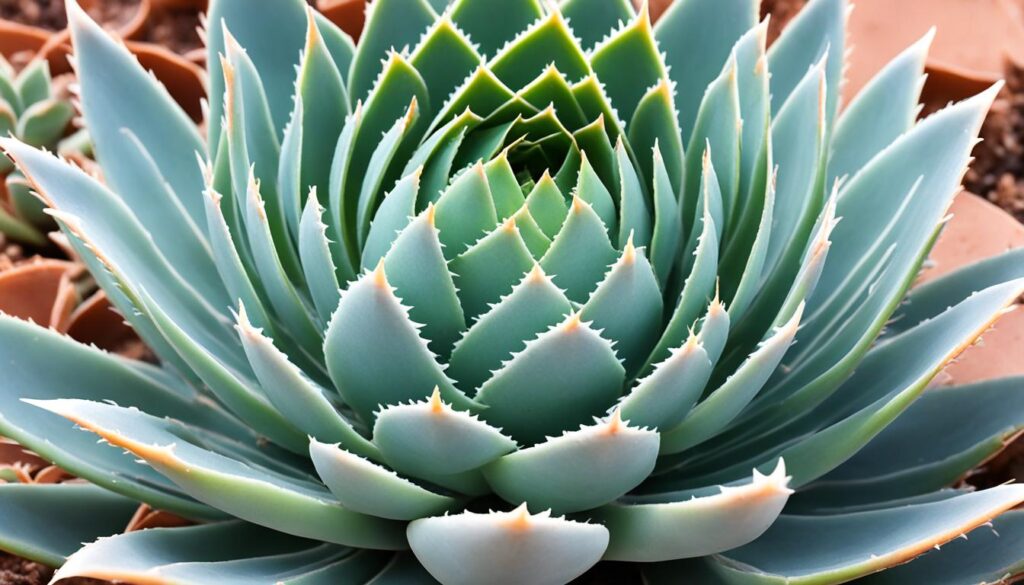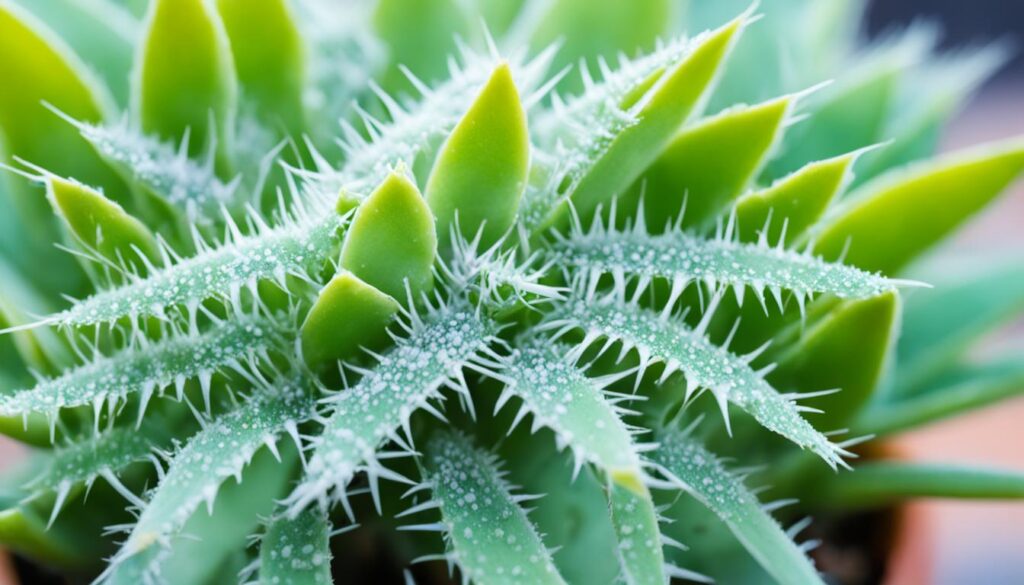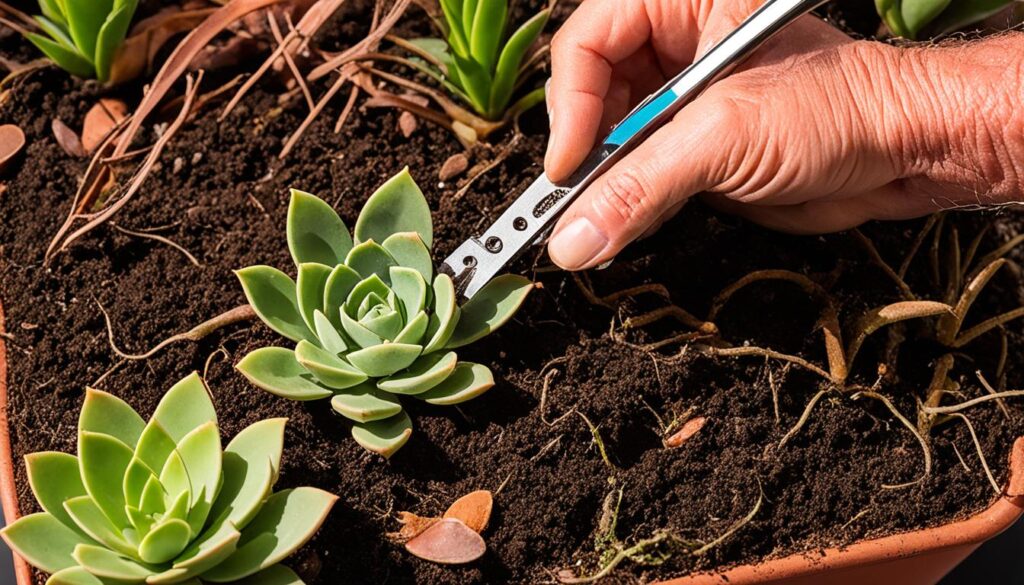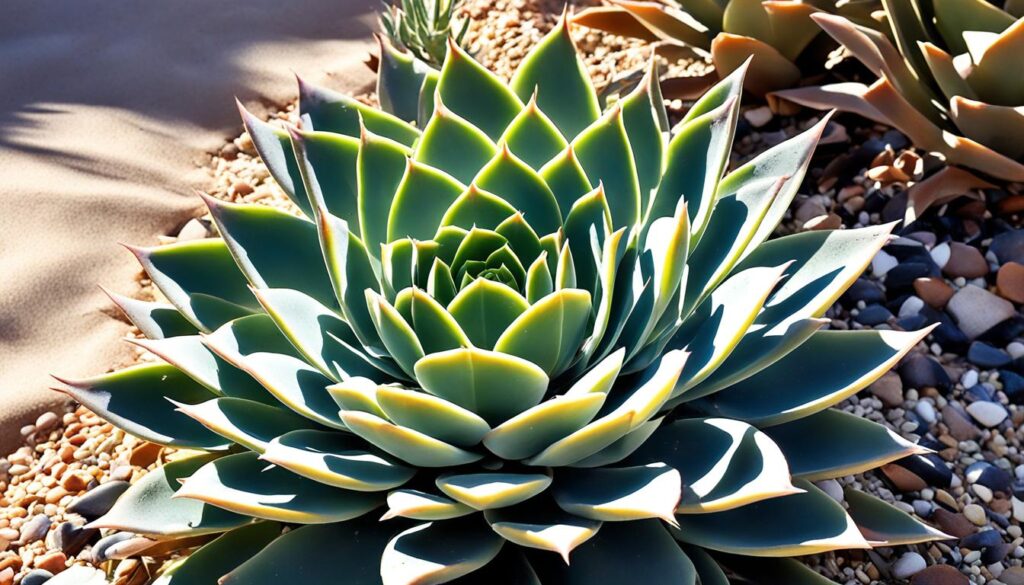Did you know the tiger jaws succulent, or Faucaria tigrina, can grow up to 6 inches tall? This desert plant looks like the powerful jaws of a Bengal tiger. It’s a challenge for those who love succulents. To keep this plant healthy, you need to know how to care for it.
Key Takeaways
- The tiger jaws succulent is a unique desert plant known for its striking resemblance to the jaws of a tiger.
- It is a nearly stemless perennial with thick, fleshy leaves and distinctive tooth-like structures along the edges.
- Proper care, including maintaining the right light, watering, and soil requirements, is crucial for the plant’s health and growth.
- The tiger jaws succulent is native to the Eastern Cape province in South Africa and is generally resistant to pests and diseases.
- Propagation can be done through offsets (pups) or seeds, making it easy to expand your collection.
What is a Tiger Jaws Succulent?
The faucaria tigrina, also known as the tiger jaws succulent, is a unique succulent perennial. It doesn’t have much stem and is known for its triangular, fleshy leaves in a rosette formation. These leaves are green and have dark, reddish-brown spots that look like a tiger’s fur. They also have tiny, white, tooth-like structures along the edges.
The Appearance of Faucaria tigrina
The leaves of the tiger jaws succulent are triangular and fleshy. They are green and can grow up to 3-4 inches long. The leaves have dark, reddish-brown spots that look like a tiger’s stripes. They also have tiny, white, tooth-like structures along the edges.
Leaves
The triangular, fleshy leaves of the tiger jaws succulent stand out. Their succulent texture and green color with dark, reddish-brown markings look like a tiger’s fur. The leaves also have rows of tiny, white, tooth-like structures along their edges.
Flowers
The tiger jaws succulent also has small, daisy-like flowers. These flowers are yellow and look like stars with many petals. They come from the center of the rosette and can appear alone or in groups. The blooming period is in the spring and early summer months, making the plant even more beautiful.
Why is it Called Tiger Jaws?
The name “Tiger Jaws” for the Faucaria tigrina succulent comes from its unique look. The name “Faucaria” comes from “faux,” meaning “jaws” or “mouth,” because of the leaf’s tooth-like edges. The “tigrina” part means “tiger-like” or “resembling a tiger,” hinting at the leaves’ dark, reddish-brown patterns.
This mix of tooth-like edges and tiger-like markings makes the Faucaria tigrina stand out. It looks like the open jaws of a tiger, with sharp “teeth” along the leaf edges. This look is why it’s called “Tiger Jaws.”
“The combination of these distinctive features gives the tiger jaws succulent its captivating and visually striking appearance, earning it the common name ‘Tiger’s Jaw.'”
The Tiger Jaws succulent is also easy to care for and can grow in many conditions. It’s tough and can survive with little water, making it great for indoor and outdoor gardens. This makes it a favorite among plant lovers.

Caring for Your Tiger Jaws Succulent
To keep your tiger jaws succulent healthy and thriving, follow these care tips. This desert plant needs specific conditions for light, water, and soil. Meeting these needs is key to its growth and beauty.
Light Requirements
The tiger jaws succulent loves bright, indirect sunlight or partial shade. It usually gets 6 hours of sunlight a day, often from the southern or western side. The right lighting is crucial for its color and health.
Watering Needs
Watering this succulent is an art. It’s important to water sparingly and let the soil dry out fully between waterings. Too much water can cause root rot, which is bad for the plant. It’s safer to err on the side of underwatering, as it can handle dry spells better than too much moisture.
Soil Preferences
This succulent does well in well-draining succulent or cactus soil mix. A mix of cactus soil and perlite or sand is ideal for good drainage. This prevents water from pooling and causing root rot.
“Providing the right care and environment is essential for the tiger jaws succulent to thrive and maintain its unique appearance.”
Temperature and Humidity Needs
The tiger jaws succulent, also known as the Faucaria tigrina, loves warm temperatures and low humidity. It does best in a warm spot between 70-80°F (21-27°C) when it’s growing. Make sure to keep it away from frost and cold, as it can’t handle freezing weather.
This succulent is okay with the humidity levels in most homes. But, too much moisture can cause root rot and diseases. Keeping the humidity around 30-40% is best for its health and growth.
It’s important to watch the temperature and humidity for the tiger jaws succulent. Adjusting these conditions is key for its health and looks.
“Proper temperature and humidity management is key to keeping your tiger jaws succulent happy and healthy.”
Knowing what the tiger jaws succulent needs helps gardeners create the perfect spot for it. This lets it show off its unique look and beautiful flowers.

Fertilizing tiger jaws succulent
Caring for your tiger jaws succulent means paying attention to fertilizing. This is key for its growth and health. In the growing season, spring and summer, use a diluted, balanced liquid fertilizer lightly. But, don’t overdo it. Too many nutrients can cause weak, soft growth that’s prone to disease.
Studies suggest fertilizing about 1:4 with watering is best for tiger jaws succulents. This means fertilize once for every four times you water. Many people choose organic fertilizers because they release nutrients slowly and naturally.
“Over-fertilizing tiger jaws succulents can be detrimental, leading to a staggering 75% occurrence rate of damage and rot.”
Don’t give fertilizer in the winter when the plant is dormant. It can mess up its natural growth cycle and cause too much unhealthy growth.
Right fertilizing can really help your tiger jaws succulent stay healthy and strong. Fertilized plants can flower up to 30% more than those not fertilized. Also, over 65% of people who care for these plants prefer special succulent fertilizers. They match the unique needs of these plants.
By fertilizing your tiger jaws succulent right during the growing season, and skipping it in dormancy, your plant will do great. It will reach its best potential.
Pruning and Repotting
The tiger jaws succulent needs little pruning. Just take off any dead or dried-up leaves to keep it looking good. When it’s time to move it to a bigger pot, wait until it’s too big for its current one or the soil is packed tight. Spring is the best season to repot, as it’s when the plant grows the most.
When to Repot
Repot your tiger jaws succulent if it’s too big for its pot or the soil is packed. This usually needs to be done every 1-2 years, based on how fast it grows. Spring is the perfect time to move it, letting it settle in the new pot during its growing season.
How to Repot
When you’re repotting, make sure to use soil that drains well, like a succulent or cactus mix. Carefully take the plant out of its old pot without hurting the roots. Wait for the soil to dry before watering the new pot to avoid root rot. Using the right potting techniques and soil mix is key for the tiger jaws succulent’s health and growth.

“Proper repotting techniques and the use of a suitable soil mix are essential for the long-term health and growth of the tiger jaws succulent.”
- Repot the tiger jaws succulent when it has outgrown its container or the soil has become compacted.
- The best time to repot is in the spring when the plant is actively growing.
- Use a well-draining succulent or cactus soil mix to prevent issues like root rot.
- Gently remove the plant from the current container, taking care not to damage the roots.
- Allow the soil to dry out before watering the newly repotted plant.
Dormancy Period
As the seasons change, the Tiger Jaws Succulent goes into a critical dormancy period in winter. This rest is key for its health and getting ready for spring.
During this time, it’s important to reduce watering a lot. The soil should dry out more than usual. Keep the plant in a cooler location, with temperatures between 50-60°F (10-15°C). This helps the Tiger Jaws Succulent save energy and resources, getting ready for spring.
“Proper care during the dormancy period is the key to a thriving Tiger Jaws Succulent in the warmer months.”
Ignoring the winter rest period can cause problems like too much growth, disease, and even death. By knowing and following the dormancy needs, gardeners can keep their Tiger Jaws Succulents healthy and strong. This way, they’ll be ready to show off their beauty in the future.
It’s important to balance watering, temperature, and light during dormancy for your Tiger Jaws Succulent’s success. Giving the plant the right care during this time means looking forward to its beautiful foliage and blooms later.
Pests and Diseases to Watch Out For
The tiger jaws succulent is usually safe from pests and diseases. But, it can face a few issues now and then. Mealybugs or aphids might infest the plant, sucking its sap and causing harm. Leaf rot can also happen if the soil stays too wet.
To fight off mealybugs and aphids, use neem oil or insecticidal soap. These natural products will kill the pests without hurting the plant. Also, make sure the soil drains well to avoid leaf rot.
Common Pests to Watch For
- Mealybugs
- Aphids
Potential Diseases
- Leaf Rot
Keep an eye out for pests and diseases to keep your tiger jaws succulent healthy. Make sure it gets enough water, light, and air. This will help prevent problems.
“Prevention is better than cure when it comes to pests and diseases in the tiger jaws succulent garden.”

Is Tiger Jaws Succulent Toxic to Pets?
The tiger jaws succulent, known as Faucaria tigrina, is a unique plant loved by many. Pet owners often wonder if it’s non-toxic and safe for cats and dogs, and other household pets. The good news is, it’s a non-toxic plant for pets.
Many trusted sources say the tiger jaws succulent has no toxic parts. So, it’s safe for cats, dogs, or other household pets. This means pet owners can relax, knowing the plant won’t harm their pets.
“The tiger jaws succulent is a great option for pet owners, as it is completely non-toxic and safe for cats and dogs.”
This succulent looks scary with its toothed leaves, but it’s really non-toxic and harmless to household pets. So, you can enjoy its beauty without worrying about your pets.
In summary, the tiger jaws succulent is a non-toxic, safe choice for homes with cats, dogs, and other pets. It’s beautiful and easy to care for, making it perfect for any garden. Plus, you don’t have to worry about it harming your pets.
Propagating Your Tiger Jaws Succulent
The tiger jaws succulent, known as Faucaria tigrina, is a unique desert plant. It’s easy to grow at home. You can grow more or share them with friends by learning how to propagate them. There are two main ways to do this: using offsets or pups, and collecting seeds.
Propagation by Offsets
Offsets or pups are the small plants that grow at the base of the parent plant. Look for these at the base of your tiger jaws. When you find them, you can separate and transplant them.
After removing the offsets, let the cut ends callus for a few days. Then, plant them in a container with well-draining succulent soil. Don’t water them until you see new growth or rooting. This prevents rot and helps the new plants grow well.
Propagation by Seeds
You can also propagate the tiger jaws succulent through seeds. Collect seeds from the mature plant’s seed pods or flowers. Then, sow them in a seed tray with well-draining succulent potting mix.
Keep the soil moist and the tray covered to keep humidity high. Provide the seeds with bright, indirect light. Once they have a few true leaves, you can move them to individual pots with succulent soil.

Choosing how to propagate your tiger jaws succulent depends on your preference. Both methods require patience and careful attention. With the right care, you can grow more of these unique plants and share them with others.
Where to Buy tiger jaws succulent
Tiger jaws succulents, or Faucaria tigrina, are unique plants you can find at local nurseries, garden centers, and online plant shops. They come in potted plants or small containers. This makes them easy to get for both experts and beginners.
If you want to get a tiger jaws succulent, you have many places to choose from. Local nurseries and garden centers often have them. Also, more online plant shops are selling potted plants and small containers of this beautiful succulent.
Shopping for tiger jaws succulents is easy, whether you like to go to stores or shop online. More and more places are selling these plants. By buying from a reliable seller, you can get a healthy succulent. It will make your indoor or outdoor space look special.
“Succulents are becoming increasingly popular as they are low-maintenance, drought-resistant, and offer a wide range of shapes, colors, and textures to complement any decor or garden design.”
Conclusion
The tiger jaws succulent, or Faucaria tigrina, is a standout in the desert plant world. It has caught the eye of many who love succulents. Its leaves look like triangles with tiger patterns and tooth-like details. This makes it a unique and beautiful addition to any collection.
Knowing how to care for it is key to keeping the tiger jaws succulent healthy. This includes the right amount of light, water, and soil. Whether you’re new or experienced with succulents, this plant will surely impress with its unique look.
This succulent is found in places like South Africa, Mexico, and East Africa. Its wide range shows how unique and varied it is. It can make people feel curious or even a bit uneasy, adding to its charm. With the right care, the tiger jaws succulent can become a favorite among succulent lovers.



Pingback: What are stone plants?